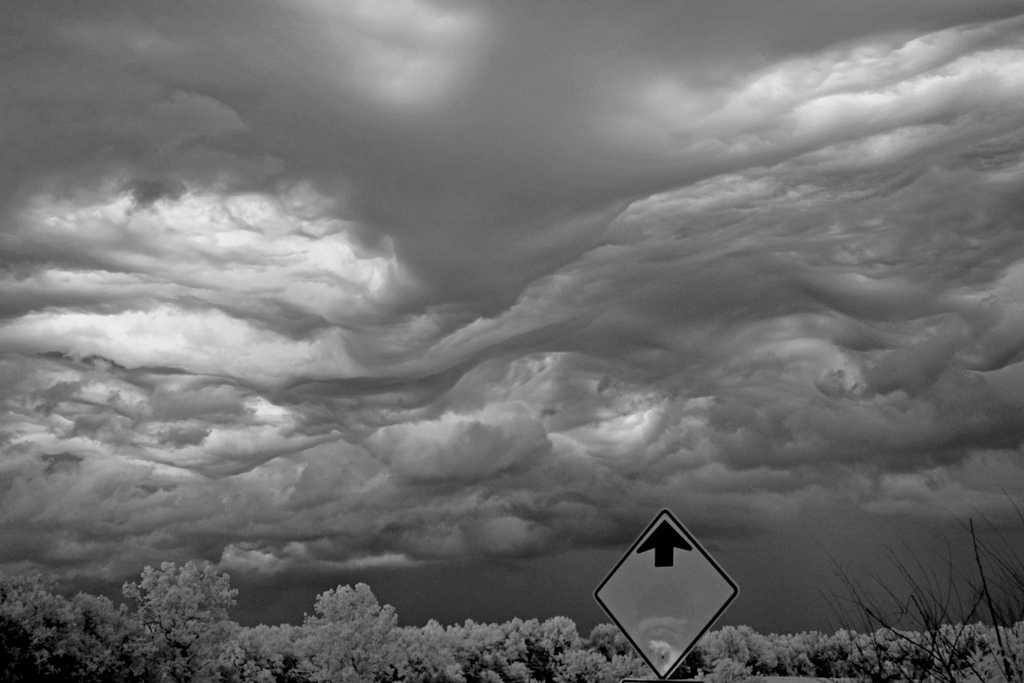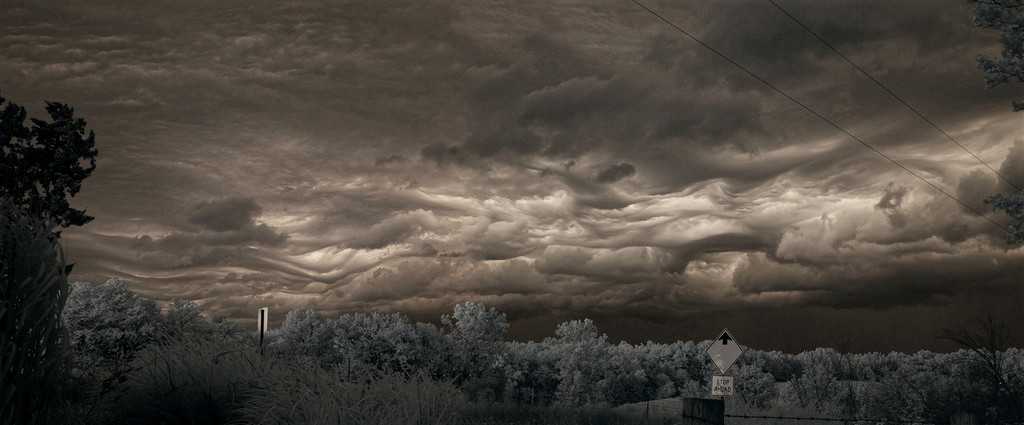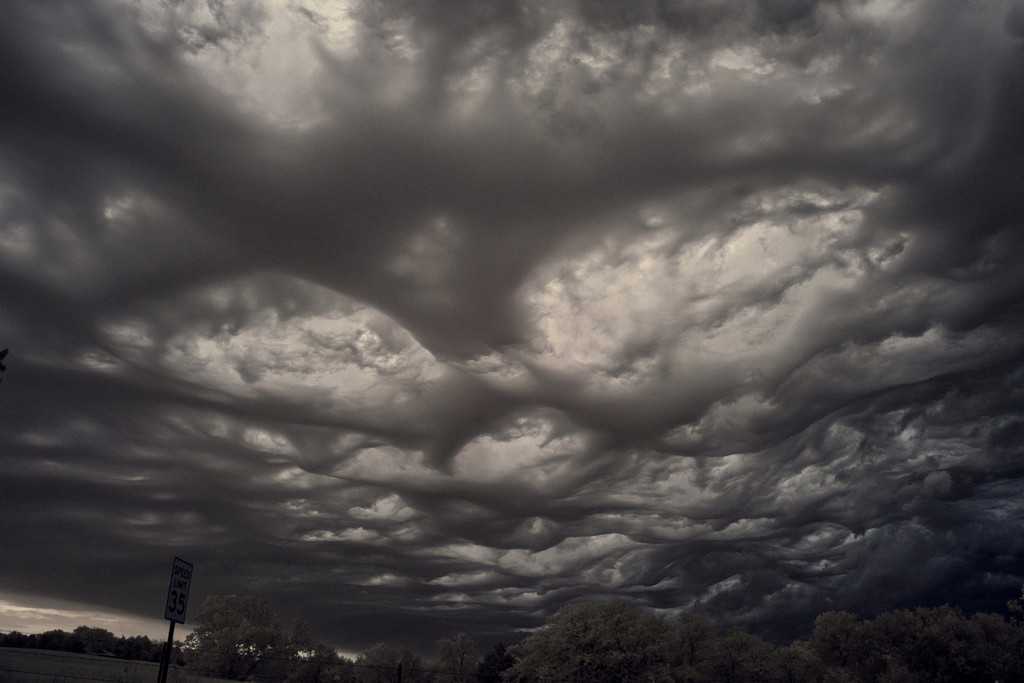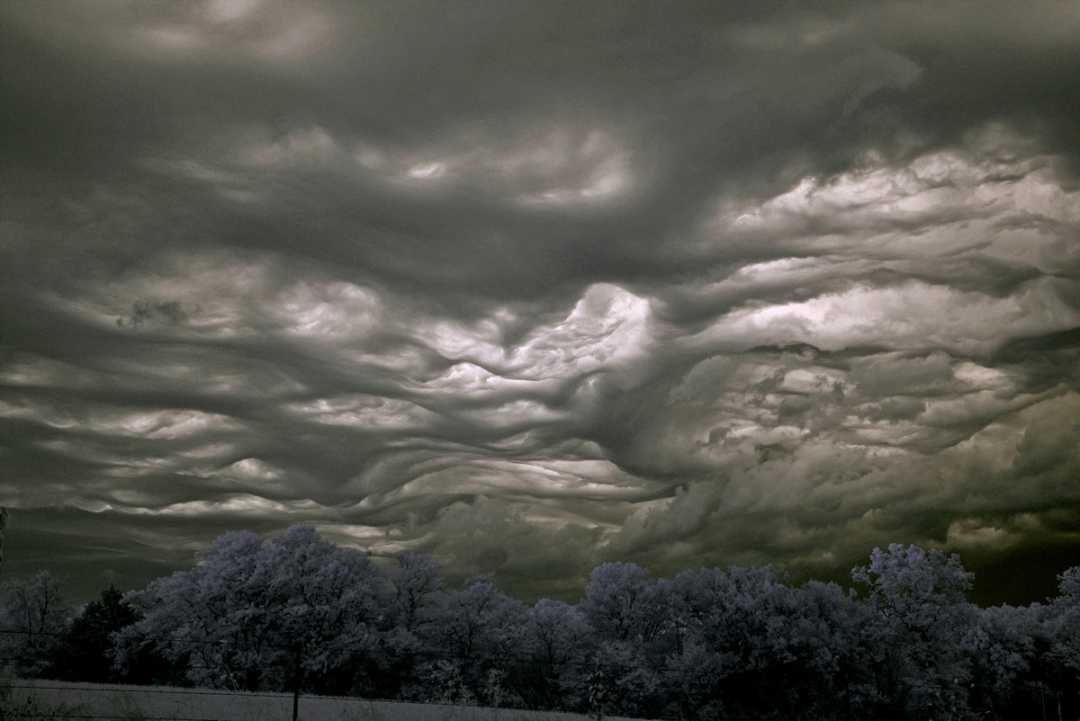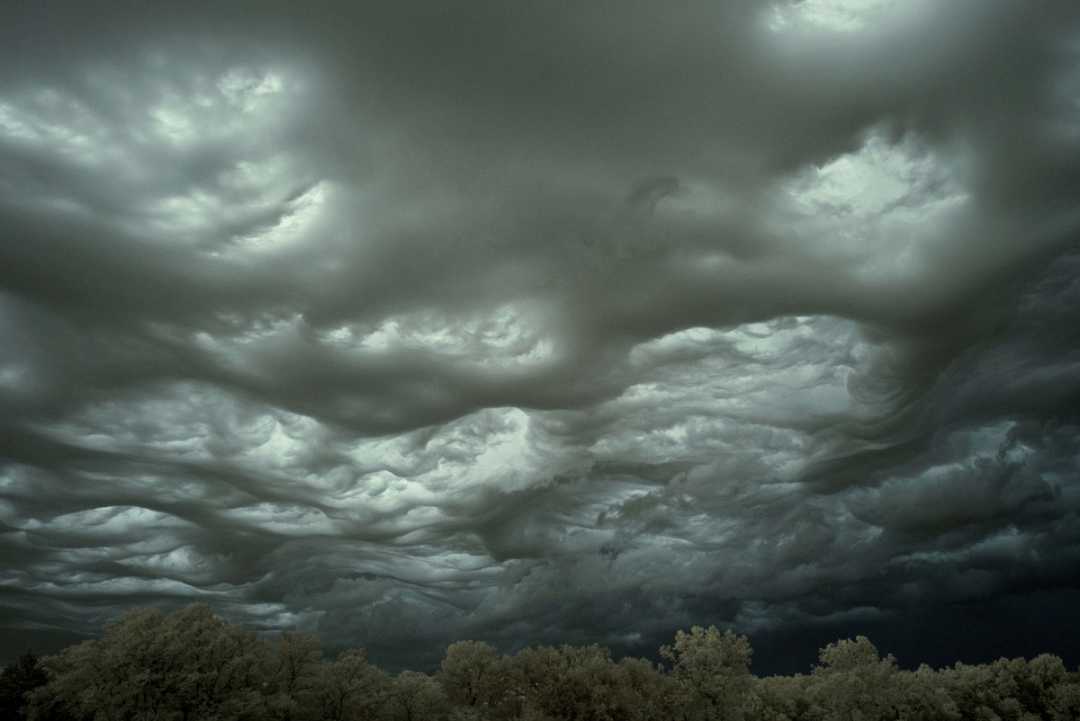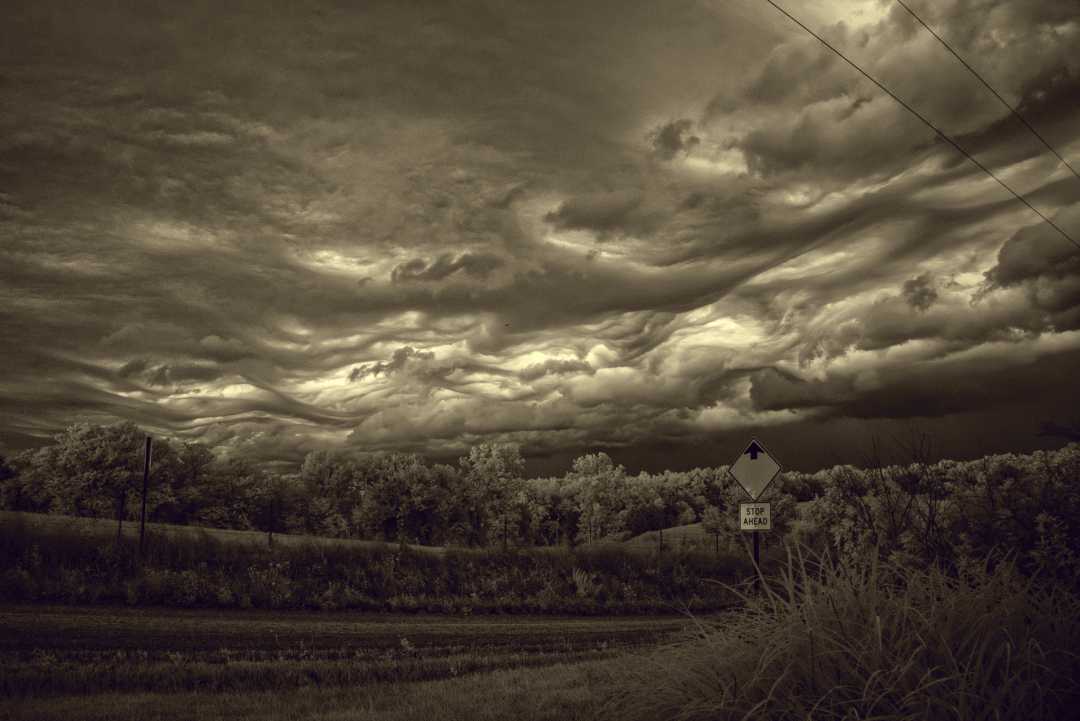Forum Replies Created
-
AuthorPosts
-
 Dave LochhaasParticipant
Dave LochhaasParticipantThanks, Hans, for noting my error. I don’t know when or why I started carrying around that incorrect knowledge in my head. You straightened out and filled in my explanation and I’m sure everyone appreciates it as it now makes more sense.
Generally speaking, I prefer the company of nerds.
This is the previous IR image I posted from the Asperitas event I witnessed on 2020-07-19. It is shown here in black and white monotone without the distraction of false color.

 Dave LochhaasParticipant
Dave LochhaasParticipantHi Michael, thanks for the questions. It is important to understand how a photo is produced from an infrared converted camera to understand what one is seeing in the photo. I’ve provided some insight previously but I left out what you asked about even though it was a question I had when I started with IR photography.
More people have seen photos from thermal imaging cameras than from IR converted cameras. The two are very different from each other but it is easy to think they are similar. A thermal imaging camera uses a specially designed sensor that “sees” only in the longer wavelength/lower frequency Far Infrared spectrum. Far Infrared has much more energy than Visible Light and Near Infrared. I’m not sure how this works to produce an image but generally, in the end, colors are assigned to temperatures.
An infrared converted camera is a camera with a sensor designed for visible light. The design of the sensor produces an image that is flat across the spectrum of red through violet. In order to do this the sensor has a sensitivity roll-off into ultraviolet at one end and into near infrared at the other end. The sensor has an infrared blocking filter to keep the near infrared (a red cast) out of the image. One can purchase a UV blocking lens filter to keep out the UV (a violet cast).
The conversion to IR photography requires the removal of the IR blocking filter and the installation of a visible light blocking filter at the sensor. Because the sensor is designed for visible light it only has a sensitivity to the roll-off in Near Infrared and can not “see” anything close to the Far Infrared spectrum. Near Infrared images do not show temperature any more than Visible Light shows temperature.
However, to either confuse or clarify, visible light is given a temperature value. Light bulbs are often rated this way, so is white balance, both using the Kelvin scale of temperature. Blue light is called cool and yellow light is called warm. This corresponds to the energy levels across the electromagnetic spectrum. Can it be said that visible light is called such because it is a range of temperatures mapped to the color we see by our personal senses?
Color created by the sensor of my IR converted camera is called false color. I guess it could be called false temperature, too. I believe the sensor maps the intensity (energy level?) from the RGB elements of the direct and reflected electromagnetic radiation that is within its range. This is the reality of the Asperitas clouds in my images, not the color or temperature but the tone..
Wow, that was a long row to hoe. I hope I’m not confused or confusing somewhere in my explanation.
I photographed the Asperitas clouds with my IR converted camera, a Fujifilm X-T10 with an XC15-45mm F3.5-5.6 OIS PZ Fujifilm lens. The sensor type is CMOS II and the sensor format is APS-C. The effective pixels is 16 Mpx. The conversion filter over the sensor cuts off visible light smaller than 665nm wavelength. My IR conversion was done by lifepixel.com and they have a vast amount of information at their website.
 Dave LochhaasParticipant
Dave LochhaasParticipantThis is another view from the Asperitas event I witnessed on 2020-07-19. The photo was taken with my infrared converted camera with the false color from the camera’s sensor.

Not only does an infrared converted camera provide cloud images with high contrast it also has other idiosyncrasies that contribute to the view in ways that truly make an experience that is vastly different than what can be seen in visible light.
The “Stop Ahead” sign has a red octagon in the center when seen in visible light. It is absent in this photo, apparently the paint being transparent to infrared. Also on this sign can be seen the IR reflection from a dusk-to-dawn lamp about 200 yards distant. This lamp had come on because it sensed a low level of visible light due the increasing cloud cover from the storm.
In the natural world the greatest reflector of IR is the chlorophyll of living plants. In bright sunlight tree leaves appear white in a photo, the limbs and trunk are usually very dark. Here, the trees appear blue-gray because of the low level of sunlight illuminating them.
In fact, chlorophyll reflects IR so well I use green grass to set the white balance on my converted camera.
 Dave LochhaasParticipant
Dave LochhaasParticipantMichael, I appreciate your continuing posts. This last Saturday, 10-03-20, about noon, I was traveling through a seven mile stretch of the Missouri River floodplain when I looked up and saw one of your Asperitas images. Your photos have apparently found a place in the pattern recognition of my brainware. This was amazing for me,
I’ve looked through your past posts and what I saw is very similar to Arizona Asperitas #776 in both appearance and color. I have not witnessed a view such as this before. Unfortunately, I was driving two-lane blacktop with no shoulder and no pull-offs and the only camera I had with me was a cell phone buried in my pants pocket.
Early in Vol 3 you spoke of the Asperitis you see in the Valley of the Sun and described its topography. Daniel did the same about Willamette Valley. I was in the Missouri River valley. I was heading west from an area that had light showers toward the thinning back edge of the front that was moving west to east. Here the flood plain is about a mile wide, completely flat, and is bound by river hills on both sides.
 Dave LochhaasParticipant
Dave LochhaasParticipantHi George, Here’s a quick reply to your questions. I have a Canon DSLR converted by lifepixel.com with their standard IR filter, equivalent to 720 nm. Six months ago I got a mirrorless Fujifilm camera converted by lifepixel.com to the enhanced IR filter, equivalent to 665 nm. This filter slightly overlaps visible light in the deep red frequencies. It does allow for a greater range of color when I manipulate the false color with RGB channel mixing (using Affinity Photo software). Both cameras provide wonderful photos of clouds illuminated by IR light.
For a variety of reasons I only shoot the mirrorless Fujifilm camera now. I do like the enhanced color of the 665 nm filter because I tremendously enjoy experimenting with the false color the camera’s sensor produces ( https://www.flickr.com/photos/davelochhaas ).
This has gotten off-thread. I would love to discuss cloud photography techniques and equipment. Let’s move this discussion to an appropriate forum of which I cannot seem to locate. Maybe it is time to start one if there is enough interest.
 Dave LochhaasParticipant
Dave LochhaasParticipantIn my last posting I succumbed to a moment of doubt about ID’s I had provided for several of my photos. Thanks to Hans for his insight and many thanks to the members posting in the Cloud Identification Help forum.
This image is composed from two photos stitched together. Asperitas clouds were just beginning to emerge on the edge of the thunderstorm line to the south on July 19, 2020, in central Missouri.
Infrared photography, false color.
This image can be seen in high resolution on my Flickr page: https://www.flickr.com/photos/davelochhaas/50341602273/in/album-72157715288024491/

 Dave LochhaasParticipant
Dave LochhaasParticipantI’ve gotten off track here and am having to rethink what I’ve been calling Asperitas cloud features. Today’s Cloud-a-Day of Stratocumulus lacunosus makes it clear that that has been a dominant feature in what I have been calling an Asperitas event.
It is likely that only a few of my photos from the 140 I shot (in IR photography) over 25 minutes during the July 7, 2020, event are of Asperitas clouds. Checking against the International Cloud Atlas I see that most of my photos do not fit the description and do not belong in this part of the forum.
On the plus side I witnessed an event that is burned in my brain but has still not completely coalesced into understanding.
The first photo may or may not contain a small patch of Asperitas. The second photo is also from the event and was solidly identified by today’s CAD, It has features typical of many of my photos on that day.
I have not located a description of how Asperitas clouds are formed and I am most curious if their existence is related in some way to how Stratocumulus lacunosus are formed.


 Dave LochhaasParticipant
Dave LochhaasParticipantThanks, Michael, I think I’m now heading in the right direction on processing at a smaller scale. My first photos were a whopping 2048 x 1368 when submitted.
I like your photo, Arizona Asperitas#781. There seems to be some orderly structure to the chaos that I’ve seen in some of my photos. It’s hard for me to imagine how the different water vapor densities stay together in an asperitas cloud formation without becoming a homogeneous mix in all the turmoil.
This is the last photo (infrared photography) of my July 19th asperitas encounter. I took it as I retreated to my garage when large drops of rain began to fall. This is a view to the east. The dark area of thunderstorms that had been sliding by to the south had widened and was approaching my backside from the west. The asperitas clouds were losing structure and drifting to the northeast. Winds were still gusting but had become northerly, different than the earlier random gusts from every direction. It took another half hour for the transition to full thunderstorm.

 Dave LochhaasParticipant
Dave LochhaasParticipantI hear voices in the sky! I don’t think these are angels.
(Infrared Photography)

 Dave LochhaasParticipant
Dave LochhaasParticipantThanks for the welcome to the forum. This is such an inspiring group of people. It truly made my day to have my first two contributions so warmly received.
I’ve been comparing the photos I submitted to how they were presented in this forum. My photos as seen here are considerably smaller in size, have considerably less resolution, and are considerably more jpeg compressed than they were when submitted. I am also guessing that with something that can be as detailed as asperitas clouds a short view may be better than a long view. My big fat photos need to go on a diet.
The following two photos are also from the July 19th asperitas event. I have cropped these photos, reduced them to 1200 x 800, and changed the jpeg compression to 90% quality, This resulted in an overall size around 200 Kb.
So let’s see what happens. I welcome all the tips, tricks, and critiques anyone has to offer. Thanks.

 Dave LochhaasParticipant
Dave LochhaasParticipantThis photograph was shot several minutes after my previously posted photo. The fun was really ramping up at this time. I was practically giggling, it was so overwhelming.

 Dave LochhaasParticipant
Dave LochhaasParticipantHello All, I’m Dave from central Missouri, USA. This is my first post to a forum and actually I’m a little baffled on how to do this.
I almost exclusively shoot clouds with an infrared converted camera. I love the way that infrared light illuminates clouds providing enhanced contrast to what visible light illumination provides. This photo is in monotone but I frequently leverage my camera sensor’s response to invisible IR light and produce colors very different than what is seen with visible light.
On July 7, 2020, at 18:10 CDT, I witnessed 25 minutes of the writhing chaos of asperitas clouds from my rural home. I shot over 140 photos with my infrared converted camera. This photo is from early in the sequence.

-
AuthorPosts


